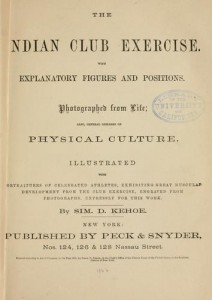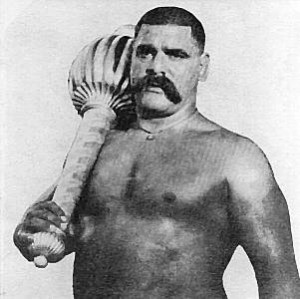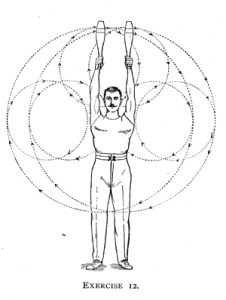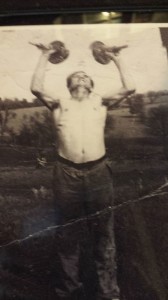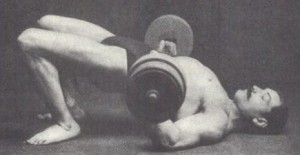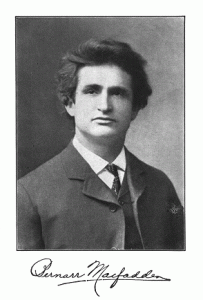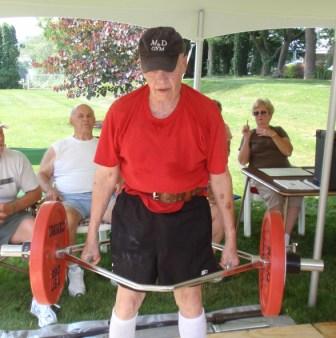The Gada: Part III
by Thom Van Vleck
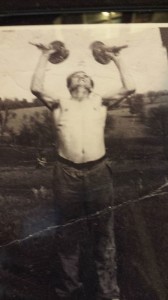
Dalton would do any kind of movement he did with a dumbbell with his modified "Gada" or "Indian Club" dumbbells.
In part three I said I’d get to how you would train Dalton Jackson style with the Gada. I first want to explain to you that his is not intended to be a comprehensive training program. It is very simply what I remember seeing my grandfather do. Upon reviewing his notes and memories of our talks I know that he studied Arthur Saxon, Eugene Sandow, Sig Klien, Earle Liederman, The Great Gama, and Charles Atlas. These 5 weren’t the only ones, but I would say most of his training came from these men. I know he ordered courses from Klien (I still have it and it’s autographed!), Liederman, and Atlas. What you are getting are my recollections of what he did that I know know to be related to the Gada.
The first was basic dumbbell work. Very simple, Dalton would do any kind of dumbbell work using these “off set” dumbbells you see in the photo above. The photo has him doing some basic dumbbell presses with the weight “top heavy”. He also would switch it to make it bottom heavy. I recall when he retired at 65 he worked hard for the next 7 years and got in tremendous shape. His goal was to duplicate some feats of strength at age 75 he had done at 50 and he came very close! His body weight was at least 220lbs around age 70 but my Uncle Phil says he got as heavy as 240lbs! All I know is I recall his forearms being so large that they made his upper arm look small. I believe using the “gada” style dumbbells helped in that development. So I would do presses, various curls, cleans, snatches, top heavy, bottom heavy….he was a big believer in mixing his workout up so he rarely did the same thing twice.
The next thing I recall is your basic Indian Club swings. I didn’t see him do this often but he would do one or two and get them rotating around. This involved swing the clubs around and I believe he mostly did this to loosen his shoulders up. I wish I had paid more attention to the specifics but I do know this, I found an illustration in his notes that he had cut out of some magazine long ago that had an illustration of Sim Kehoe doing “Figure no. 5” from his book “Indian Club Exercises” which can be found online.
Specialized work. My grandfather believe that his training should closely follow what he was trying to get better at. For him this was never a contest so it was life events. For example if winter was coming he would load a long barbell and do “snow shovel” movements, 5 reps left, then 5 reps right. He always wanted to be balanced! A few years ago I know Al Myers made an implement that mimicked the sheaf toss movement and it was bar like a pitch fork that could have plates loaded on the “business” end. I remember Dalton told me that he had a “corn shucking” working for when he shucked corn by hand! He would use his offset dumbbells whenever they suited this purpose.
Another “quirk” to my grandfather’s training was that he would always load his left hand a little heavier. Regardless if it were the “Gada” dumbbells or a barbell or dumbbells. He told me that his left side was always weaker and needed more work since his right side got more work on the job and doing chores. To this day I keep his old barbell set loaded in my gym in such a fashion. I’ve never heard of anyone training that way.
I wish I’d paid more attention. To this day I’ll see something and think, “I saw Pop do that!”. As I remember stuff I try and write it down. He wrote volumes of journals and I go through them occasionally and find things I missed or didn’t connect the dots at the time. He often wrote in a sort of short hand that makes him a tough read sometimes. In a way it’s like finding a little treasure every time I revisit! I hope you have enjoyed my three part series and find some time to try a “Gada” out in your training program!
